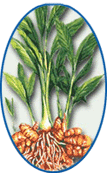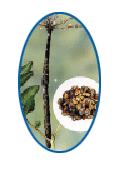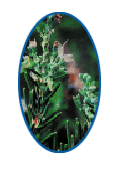The removal of Vioxx® from the market and recent warnings about other conventionally used COX-2 inhibitors, has resulted in a renewed interest in natural approaches to the management of pain and inflammation.
A brief note on COX:
Oxygenation of arachidonic acid is increased in inflammation. Under these conditions, the production of inflammatory mediators, the prostaglandins (PG), through the action of the enzyme COX (cyclooxygenase) and leukotrienes (through the action of the enzyme 5-lipoxygenase) is enhanced, leading to increased inflammation and pain. It is known that whenever there is trauma or injury, there is an increase in the production of PGE2 at the site in response to the body's immunological defense to the damage.



In 1991, researchers identified two isoforms of the cyclooxygenase enzymes, COX-1 and COX-2. Of these, COX-1 is reported to be responsible for the physiological housekeeping functions. COX-1 is produced in most tissues, and it is involved in the maintenance of normal cellular functions such as in maintaining the integrity of gastrointestinal tissues including the stomach lining and circulatory functions such as the flow of blood to the kidneys and the functioning of the platelets. COX-2 is an inducible isoform of cyclooxygenase, expressed in response to proinflammatory stimuli and is found in the brain cells, reproductive tissues, kidneys and bone-forming cells (osteoblasts).
Nonsteroidal anti-inflammatory drugs (NSAIDs), which inhibit both COX-1 and COX-2, are widely used to effectively treat acute and chronic inflammation and pain. These include the OTC drugs such as aspirin, ibuprofen and naproxen. As they are not selective to COX-2, inhibition of COX-1 as well, causes undesirable effects such as gastric ulceration. For example Aspirin has been reported to induce aspirin-sensitive asthma, potentially linked to its effects on COX-1.
The introduction of celecoxib (Celebrex) and rofecoxib (Viox), COX-2 selective inhibitors was effected to decrease the adverse effects that are typically associated with inhibition of COX-1. The recent concerns about the safety of COX-2 selective inhibitors pertain to a possible increase in the risk of cardiovascular events such as myocardial infarction associated with the 'coxibs'. It is postulated, but not proven, that inhibition of prostacyclin synthesis by selective COX-2 inhibitors, may increase the risk of thrombosis in some patients. 
The Natural Approach:
Natural alternatives such as herbal extracts of turmeric, ginger, rosemary, green tea and their active phytochemical constituents are reported to be effective COX-2 inhibitors. Others such as Boswellia serrata extract (boswellic acids) inhibit the formation of inflammatory leukotrienes. Some of these herbal extracts such as curcuminoids from turmeric are known to also inhibit other inflammatory molecules such as cytokines.
- Boswellic acids are specific nonredox inhibitors of 5- lipoxygenase the enzyme which catalyzes conversion of arachidonic acid to inflammatory leukotrienes. Boswellic acids also inhibit the enzyme human leukocyte elastase (HLE), matrix metalloprotease enzyme (MMP) which catalyzes connective tissue breakdown. Boswellic acids show anti-complementary activity. Complement proteins are known to trigger inflammatory mediators. 2
- Curcuminoids from turmeric roots exhibit an inhibitory effect on COX-2 and on the production of other inflammatory mediators such as interleukins and TNF-alpha (that generates inflammatory cytokines). Such effects are believed to be responsible for the beneficial role of curcuminoids in colorectal cancer. 3
- Green tea polyphenols are also reported to inhibit COX-2 and TNF-alpha. Similarly, ginger extract (6-gingerol and gingerdiones) is a dual inhibitor of inflammation, acting by inhibiting the formation of both prostaglandins and leukotrienes. 4
- Ursolic acid (a natural constituent of Rosemary extract and Tulsi extract), its isomer, oleanolic acid (found in olive leaf extract) and rosmarinic acid (found in sage, rosemary , Tulsi, lemon balm and other medicinal plants) also inhibit COX-2 Ursolic and oleanolic acids also inhibit HLE activity. A study that compared the COX-2/COX-1 selectivity ratios of ursolic acid and oleanolic acid to those of the traditional NSAIDS, ibuprofen, naproxen, and indomethacin, and NS-398 (a synthetic selective COX-2 inhibitor), reported the following rank order : NS-398 > ursolic acid > oleanolic acid > ibuprofen > naproxen > indomethacin. 5
References:
1.www.ibuprofen-foundation.com;
2.www.boswellin.com;
3.www.curcuminoids.com,
4. Free Radic Biol Med . 2002 Oct 15;33(8):1097-105.; 5. J. Nat. Prod. 61: 1212-1215.
Contact Sabinsa Corporation for more information on these and other natural COX-2 inhibitors.







